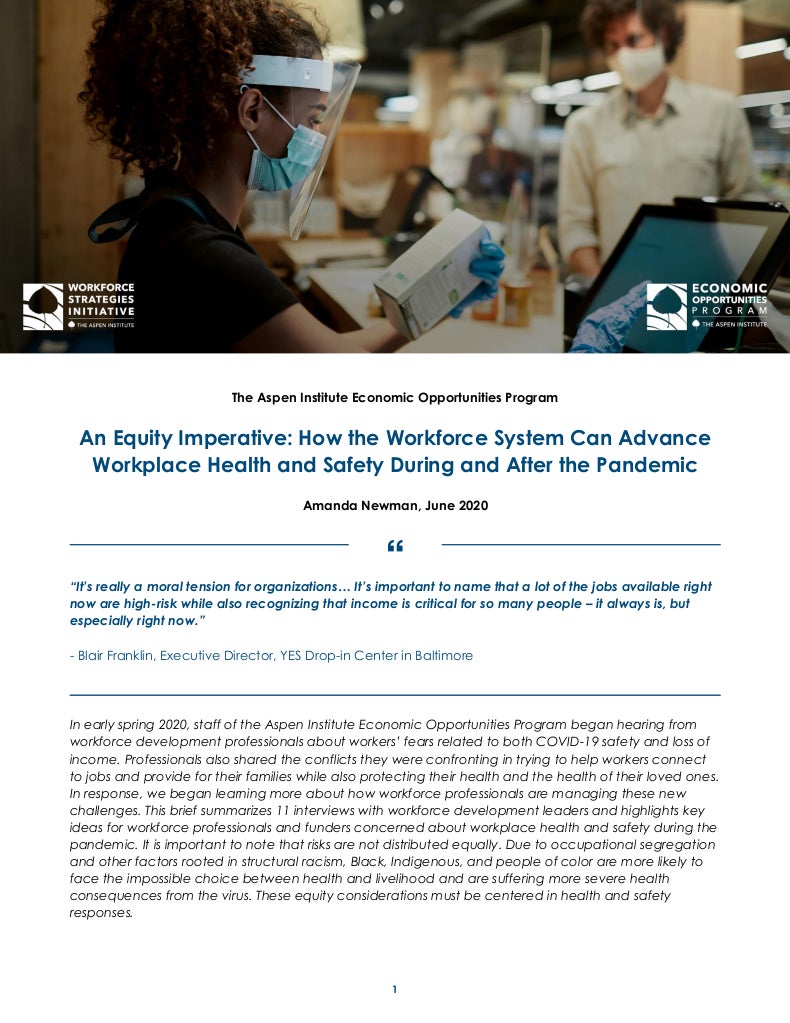Every worker deserves a job with healthy and safe working conditions. The outbreak of the novel coronavirus, however, has demonstrated that for far too many people this is not the reality. The pandemic has created a new set of workplace hazards, forcing many people looking for work to make difficult choices between providing for their families and protecting their health and the health of their loved ones. As businesses reopen, more people are reentering jobs that pose risks. And these risks are not distributed equally. Due to factors rooted in structural racism, Black, Indigenous, and workers of color performing critical services during the pandemic are both more likely to experience the health consequences of the virus and to be concentrated in jobs with greater exposure.
Serving as intermediaries between workers and employers, workforce development professionals have a crucial role to play in strengthening workplace health and safety during and after the pandemic. In the early months of the crisis, Economic Opportunities Program staff spoke with workforce development leaders across the country as they strengthened existing strategies and considered new approaches to help workers protect themselves on the job. Professionals on the front lines of connecting people to work – from caseworkers to job developers to program directors – can learn from their approaches to inform their own strategies.
In this brief, we highlight key ideas for how the workforce development system can promote workplace health and safety during the pandemic. It is important to note that workforce professionals are themselves navigating a crisis, responding to historic unemployment and serving the public as resources rapidly decline. This brief also includes ideas for public and philanthropic funders who seek to support the workforce development field to advance workplace health and safety.
Please get in touch to share how you are navigating workplace health and safety challenges during the pandemic or to give feedback about this brief. Our hope is that practices strengthened during the pandemic can set the foundation for safer, fairer, and more equitable working conditions that support more workers to thrive in the long term.
Share
Tweet Brief: “An Equity Imperative: How the Workforce System Can Advance Workplace Health and Safety During and After the Pandemic” by @amandabnewman of @AspenWorkforce.
Tweet This brief by @amandabnewman of @AspenWorkforce highlights key ideas for how the workforce development system can promote workplace health and safety during and after the #COVID19 pandemic.
Tweet Every worker deserves a job with healthy and safe working conditions, but #COVID19 has shown this is not the reality for too many workers. What can workforce professionals and funders do to help protect people on the job?
Tweet #COVID19 created a new set of workplace hazards and is forcing many workers to choose between providing for their families and protecting their health. How can workforce practitioners and funders curb this trade-off?
Tweet The risks of the #COVID19 pandemic are not distributed equally, as BIPOC face greater exposure on the job and more adverse health impacts. How can the workforce system help address these inequities?
Tweet Strengthening workplace health and safety during the #COVID19 pandemic can set a foundation for safer, fairer, and more equitable working conditions in the long term. Here’s what workforce professionals and funders can do.
For additional communications materials, including sample posts, web text, email text, and graphics to share with colleagues in your network, download our toolkit: Outreach Toolkit
Learn More
The Economic Opportunities Program advances strategies, policies, and ideas to help low- and moderate-income people thrive in a changing economy. Follow us on social media and join our mailing list to stay up-to-date on publications, blog posts, events, and other announcements.


